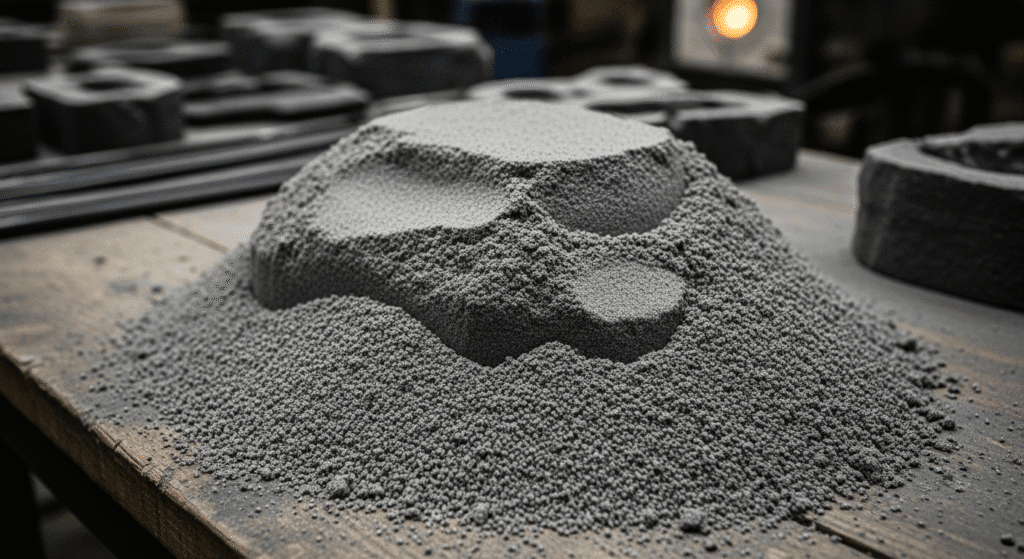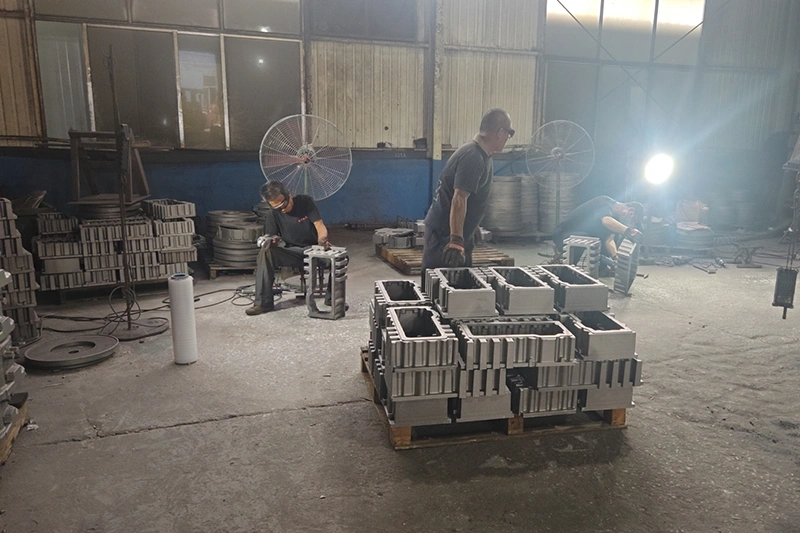Molding Sands are specially prepared mixtures of sand, clay, and water that form the molds used to shape molten metal into finished parts. Think of it like making sandcastles at the beach – except these “sandcastles” need to withstand temperatures hot enough to melt steel while maintaining precise shapes down to fractions of an inch.

Greensand is the workhorse of the foundry world, making up about 60% of all metal casting operations. Despite its name, it’s not actually green in color – “green” means it contains moisture, typically 3-8% water mixed with clay and sand.
Think of greensand like wet beach sand that holds its shape when you pack it. The moisture and clay act like glue, binding the sand grains together so they can form detailed mold shapes.
This type of sand is perfect for high-volume production because you can reuse it immediately. Just add a bit of water and clay, mix it up, and it’s ready for the next casting.
Dry sand is greensand that’s been baked in an oven at 200-300°C to remove all moisture. This heating process makes the mold stronger and more dimensionally stable, which is crucial when you’re casting large or complex parts.
The baking process takes time and energy, but it eliminates problems like steam bubbles that can form when hot metal meets moisture. You’ll see dry sand molds used for heavy machinery parts, large engine blocks, and precision components where surface finish really matters.
Loam sand contains about 50% clay content – much higher than regular molding sand. This high clay content makes it incredibly sticky and moldable, like pottery clay mixed with sand.
Foundries use loam sand for massive castings that would be impractical to make with pattern equipment. Instead of using a pattern, workers build up the mold shape using sweeps and templates, similar to how a potter shapes clay on a wheel.
You’ll find loam sand molds creating huge turbine housings, ship propellers, and industrial equipment bases that weigh several tons.
Facing sand is the premium material that directly contacts the molten metal. It’s specially formulated with fine grains and high-quality binding materials to create the smoothest possible casting surface.
This sand forms only a thin layer (about 1-2 inches) against the pattern. Behind it, cheaper backing sand fills the rest of the mold box.
Think of it like using expensive paint only for the final coat while using primer underneath. The facing sand ensures your casting has a clean, detailed surface without the expense of filling the entire mold with premium material.
Backing sand is recycled molding sand that fills the bulk of the mold box behind the facing sand layer. It’s been used before, reconditioned, and is ready for another round.
This sand doesn’t need to be as refined as facing sand because it never touches the molten metal. Its job is simply to provide support and maintain the mold’s shape during pouring.
Using backing sand is like using recycled paper for drafts while saving the good paper for final copies. It cuts costs significantly while maintaining casting quality.
System sand is the modern foundry’s answer to consistency – it’s mechanically prepared sand that maintains uniform properties throughout the entire production run. Automated systems continuously mix, test, and adjust this sand to meet exact specifications.
This sand circulates through the foundry in a closed loop. After each use, it goes through reconditioning equipment that removes metal particles, adjusts moisture, and adds fresh clay binder.
Large automotive foundries rely on system sand because it delivers identical results whether you’re making the first casting of the day or the thousandth.
Parting sand prevents the two halves of a mold from sticking together. It’s usually fine silica sand or sometimes ground limestone that’s been dried and treated to resist moisture.
Applying parting sand is like dusting flour on a cutting board before rolling dough – it creates a non-stick barrier. Without it, you’d never be able to separate the mold halves to remove your pattern.
This sand must be completely dry and free-flowing. Even a small amount of moisture would cause it to stick, defeating its entire purpose.
Core sand creates the hollow spaces inside castings, like the water passages in an engine block. It needs exceptional strength because cores are surrounded by molten metal on all sides during casting.
This sand gets mixed with special binders – either organic resins or sodium silicate – that harden when heated or exposed to CO2 gas. The result is a rigid sand structure that can withstand the pressure and heat of molten metal.
After casting, the core must collapse easily for removal. It’s a delicate balance: strong enough to maintain shape during pouring, but weak enough to break apart afterward.
The success of any casting depends on eight critical properties that determine how sand behaves during the molding process:
Greensand is by far the most common, used in about 60% of all metal castings. It’s economical, reusable, and works well for most casting applications, especially in high-volume production environments.
Generally no – mixing different sand types disrupts their carefully balanced properties. Each type is formulated for specific purposes, and mixing them usually results in poor mold quality and casting defects.

